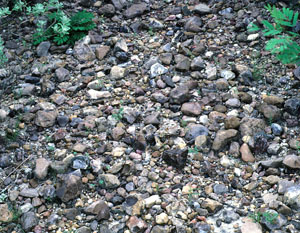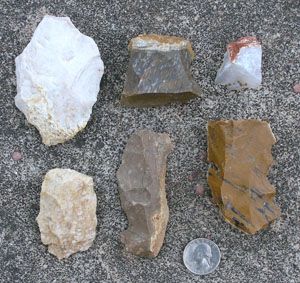“Uvalde” Gravels West
“Uvalde” gravels can be found on eroded upland ridge tops and in lag deposits in some of the small arroyos and wet-weather creeks in widely scattered places across much of the northern two-thirds of the South Texas Plains. They represent gravels deposited by ancient rivers that crossed the region hundreds of thousands or even millions of years ago washed from source areas hundreds of miles distant. Geologists attribute these deposits to the earlier parts of Pleistocene geologic period, which begins 1.8 million years ago, or even earlier, during the Pliocene Geological era (5 to 1.8 million years ago).
Since then, these ancient waterways have been all but obliterated by geological processes, especially erosion and the continuous landscape remodeling done by the drainage systems we can see today. Still, when you encounter scattered stream-rounded flint and quartzite cobbles on a ridge top in the thick of the South Texas Plains, it stretches the mind to believe that a stream or river once passed over this now high and dry terrain. The changes that Earth has undergone over geological time are very difficult for most of us to grasp.
The term “Uvalde" gravels is used here to label what could perhaps be more generally termed “ancient” gravel deposits. The geological terminology and understanding of the origins and timing of the gravel deposits have not yet proved adequate to the task of sorting these out. So, we’ll stick with the widely used term, mindful that it has been applied loosely to ancient gravels found in many different geological formations over a wide area far beyond the Uvalde area and the South Texas Plains. For convenience, we use the Nueces River as a dividing line between the “Uvalde” Gravels West and the “Uvalde” Gravels East” within the South Texas Plains.
The Uvalde gravels in the western part of the region were heavily used by prehistoric peoples as sources of stones suitable for making tools and sometimes for cooking stones (heated rocks). The gravels are composed of various types of relatively hard rocks that withstood river transport over hundreds of miles. As such, they are rounded, relatively small in size, and have cortex (exterior rinds) that often vary in color and texture from the internal material. Typically, the cortex is much darker than the interior. Of primary use to prehistoric peoples were the various kinds of siliceous rocks including chert (flint), chalcedony, quartzite, agatized (petrified) wood, and jasper.
The majority of the pieces of siliceous rocks are pebbles and cobbles, but small boulders also occur in some deposits. Most of the cobbles are relatively small, and usually no more than 6-8 inches (15-20 cm) in maximum dimension. Most pieces are tough and relatively coarse-grained, and they often contain folds, voids, and other kinds of internal “flaws,” as seen from the flintknapper’s point of view. In other words, most pieces of ancient gravel do not have ideal characteristics for flintknapping. Still, there are larger pieces of fine-grained materials that are quite suited for making large stone tools, but ideal pieces are relatively hard to find in most exposures. As a consequence, virtually every upland gravel deposit that has been exposed within the past 13,500 years has been picked over time and time again by tool-makers in search for the elusive—the best “rock-knocking” cobbles. This “high-grading” process is quite familiar to modern flintknappers and anyone else who has searched gravel deposits in hopes of finding a particularly well-suited piece of rock, the ideal needle in a rocky haystack. There are also concentrations of certain materials in some exposures.
For instance, in northwestern Duval County fairly large pieces of high quality gray quartzite are present in an obvious prehistoric quarry (“lithic procurement”) site. This site (41DV134) has an apparent outcrop of embedded boulders of a fine-grained quartz arenite, light gray in color. Nearby was a smaller outcrop of a yellow-brown quartz arenite that seemed to be of somewhat inferior quality. Some would call both materials “sugar quartzite” because flaked pieces sparkle in sunlight and sometimes seems to have sugar-like particle inclusions.
The gray arenite boulders showed considerable evidence of having had chunks removed and flaking debris littered the area. The yellow-brown boulders also had evidence of having had chunks removed. At a nearby campsite, there were numerous dart points (mostly rejects), biface fragments, and flakes made of the gray arenite, but none of the yellow-brown material. Smaller pieces of very similar arenite material, both gray and yellow-brown (some of which is quite flakeable) varieties, occur within ancient gravel exposures in northern Duval County and elsewhere in the South Texas Plains including central Live Oak County. To learn more about the Duval County quarry site, read the article linked below.
The "Uvalde" Gravels West of the South Texas Plains were major lithic resources for the prehistoric peoples of the region. Most of the tool-making materials are small and made of hard-to-knap materials, but these gravel exposures were dependable sources of smaller pieces of fine-grained materials large enough to create flake tools and small chipped stone tools. Other rocks found in these ancient gravels were sometimes used for grinding tools, hammerstones, and other useful artifacts. Some rocks were also used for hot rock cooking, although most were not well suited for this purpose.
Source:
Chandler, Charles K. and Leo Lopez
1992 A Quarry in Western Duval County. La Tierra 19(2):12-13. Download PDF
|
Uvalde gravel samples from south of Oakville in Live Oak County. The bright white specimen is a piece of chalcedony. Courtesy Glenn T. Goode. |





